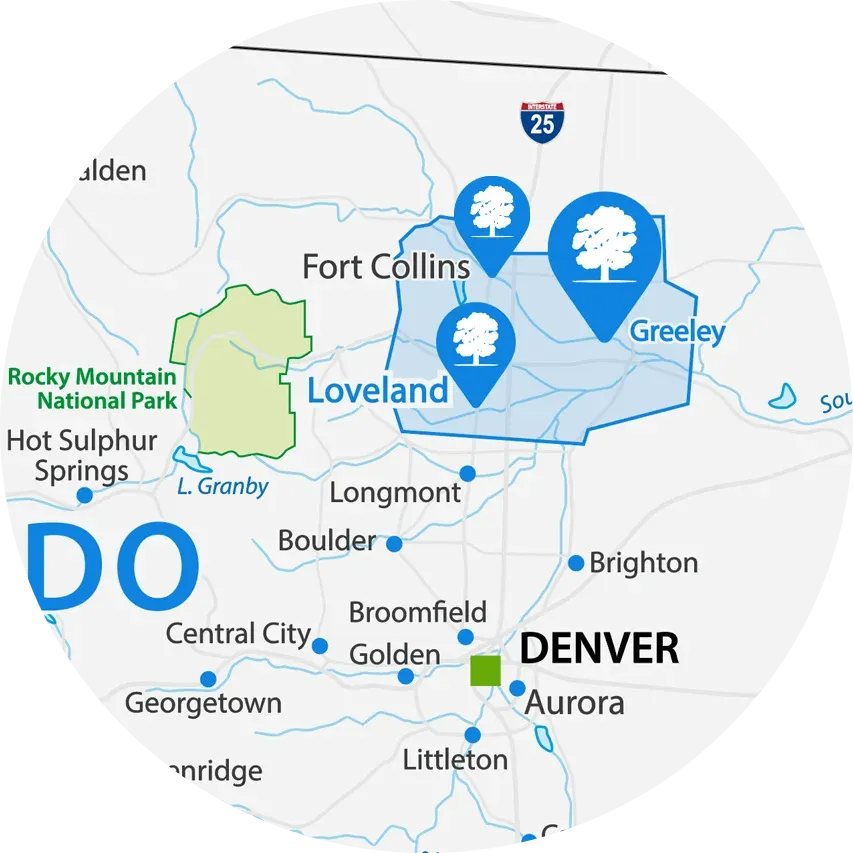Emerald Ash Borer Treatment in Colorado
The Emerald Ash Borer (EAB) is a common enemy of Colorado gardeners and homeowners. These invasive insects may have an impressive metallic green sheen, but they devastate trees from the inside out, costing property owners a fortune in tree removal and replacement.
What Is The Emerald Ash Borer?
Emerald Ash Borers are small insects that came to the U.S. from Asia, first detected in the country in 2002. While EABs were first seen in Colorado in 2013, we do not know how long they were present before then. They have been positively identified in Larimer and Weld County, but the extent of their presence in Northern Colorado is still largely unknown.
And you don’t want to be the one to find Emerald Ash Borers in your area. These tiny green beetles lay their eggs inside ash trees, and their larvae can cause colossal damage by tunneling into the layers of a tree, inhibiting the tree’s ability to transport water and nutrients.
Emerald Ash Borer Prevention in Northern Colorado
Since their discovery in the U.S., Emerald Ash Borers have killed more than 50 million trees. It only takes around 10 years for an Emerald Ash Borer infestation to take down an entire forest. Prevention is key if you want to avoid tree removal and replacements that are far more expensive than preventative treatment. A lot of over-the-counter products for EABs are only 15% effective when performed precisely and perfectly, so professional treatment is strongly recommended.
At American Tree & Turf Care, we know EAB treatment is critical. If a tree is important to you and your landscape, we’re ready to treat it so that Emerald Ash Borers don’t stand a chance.
Our EAB prevention program is part of our tree care package and includes:
- A free estimate from one of our highly-qualified technicians.
- A trunk injection of Emamectin Benzoate for maximum coverage.
- Protection that lasts for two growing seasons, at which point we reapply.
- A nearly 90% success rate according to national field trials.
You can’t wait until EAB are already a problem to protect your trees! Our team of experienced emerald ash borer experts is ready to take a proactive approach to save your landscape.
Get Your Free Quote for Emerald Ash Borer Treatment
Signs of Emerald Ash Borers
Think you might already have an Emerald Ash Borer infestation? We can help identify the extent of the damage. You may notice:
- Visible metallic-green insects on a warm, sunny day
- Bark splitting
- D-shaped exit holes
- Increased woodpecker activity
- Zig-zag galleries underneath bark
- Dead branches & thinning tree crowns
- Water sprouts or shoots growing from tree trunks
Learn more about EAB beetle damage and identification.
Emerald Ash Borer Treatment Options
Emerald Ash Borers are extremely invasive and can spread very quickly—in fact, a female EAB beetle can lay its eggs anywhere from 100 yards to 2-3 miles from its home tree. So if you notice any warning signs of a beetle infestation, consider one of the following application methods:
Trunk Injection
Trunk injection is one of the most effective EAB treatments that always requires professional help, and the one that our experts recommend the most. The insecticide is injected directly into the tree bark and can kill EABs in multiple stages of life, including both larvae and young adults. Trunk injection also offers lasting protection, usually around two years. It can be applied at almost any time of the year since it does not require optimum weather conditions to work.
Bark Spray
Bark spray is most effective for trees that are still healthy enough to transport water, though sometimes added ingredients can help the insecticide disperse. A formula containing the active ingredient Dinotefuran is sprayed on the lower trunk and then gets systematically infused throughout the tree. This is one of the quickest and simplest treatments available.
Soil Injection
Soil injections are applied directly to the soil around the base of tree trunks. These require more specialized equipment than a spray but also work best under very specific soil and weather conditions. There may also be regulations regarding how much insecticide can be injected into the soil in a given area.
Remove & Replace
Sometimes, a tree is just too far gone to respond well to EAB treatment, or the effort of removing and replacing a tree outweighs the cost of treatment. However, infested trees must be replaced with species approved by your city, and removal and replacement can become a significant time investment. A professional can help you determine what the best course of care is for your trees.
Canopy Sprays
Canopy sprays are applied to foliage, and are more useful to control and kill adult borers, but not the tree-destroying larvae. It's important to note that with canopy sprays, it is physically impossible to ensure you are covering 100% of the tree, so this treatment method is not usually recommended. Canopy sprays can be effective to curb the spread of EABs around the neighborhood, and if chosen, they have to be very carefully timed and require multiple applications.
DIY Treatment Options
While some people may be tempted by DIY treatments of ash trees in order to save money, you will lose money in the long run. DIY treatments are NOT effective, as they require the proper timing and dosage for the trees in question that only experts know—in the long run, you will still have to hire a professional for emerald ash borer treatment. Any over-the-counter insecticide products don’t contain a high enough concentration of the ingredients required to save your trees, so you could be spending time and money on treatments that, according to research, aren’t powerful enough to combat an EAB infestation.
Call American Turf & Tree Care
At American Turf & Tree Care, we use powerful trunk injections that are proven to eliminate EABs and last up to two years, so that you don’t have to worry about recurring sprays. When you call us for EAB control, our expert technicians can inspect and determine the extent of EAB damage so that we can advise on the best way forward to protect the landscape you love. Call us immediately when you notice EAB-infested ash trees or fill out our contact form if you are interested in taking a proactive approach to protecting your healthy trees.
Areas We Service
Our lawn care experts know exactly what it takes to care for your landscape. Our team has been proudly serving our neighbors in Northern Colorado since 1982. Not sure if we service your neighborhood? Check out the map or give us a call!








